Importance of Framing Theory in Mass Communication
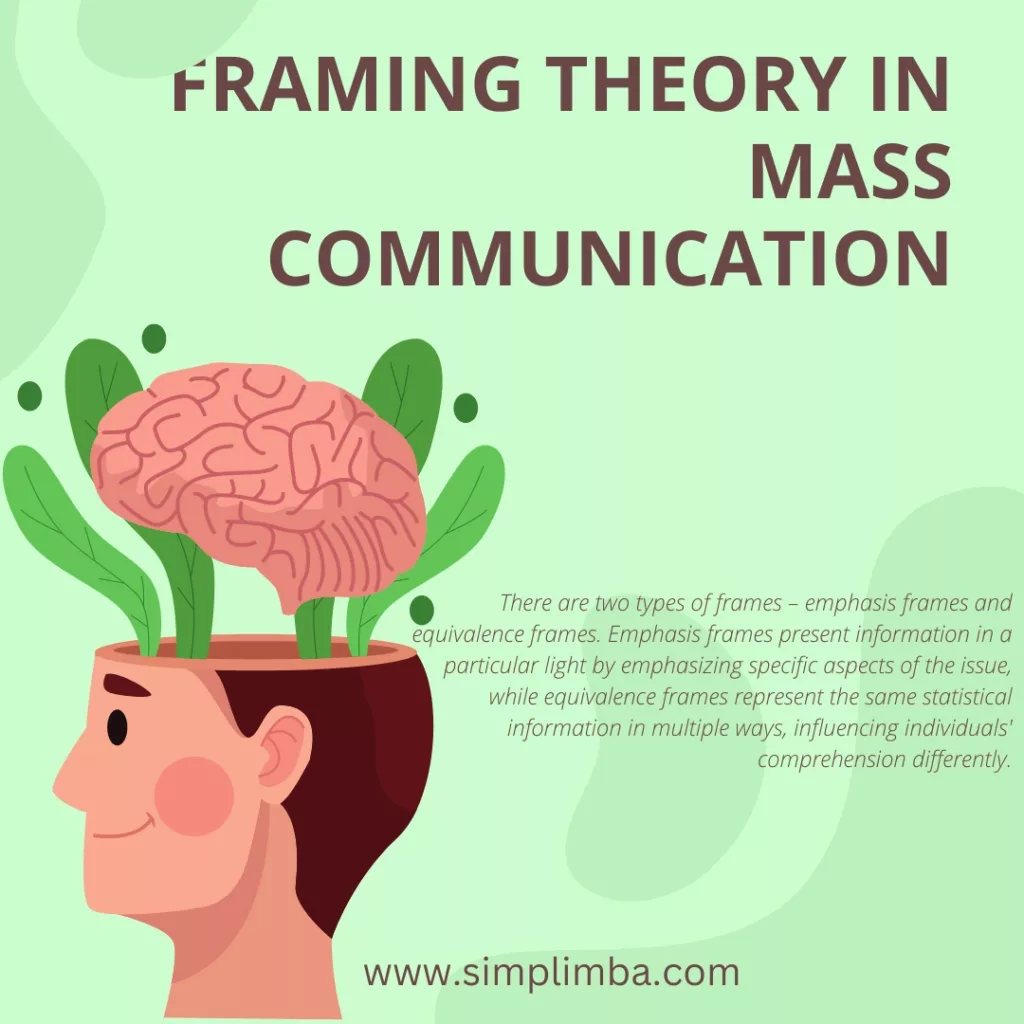
Framing theory, a significant part of mass communication, refers to the way media presents information to the public and how this presentation shapes the audience’s perception of that information. The term ‘frame’ or ‘framing’ essentially means the angle or perspective from which a news story or information is presented.
Framing helps viewers, readers, or listeners to interpret the information presented and form opinions or attitudes. In other words, the way a story is framed can significantly influence our understanding and perception of reality. Framing involves strategic choices by journalists, editors, and others in the media profession about what to include in a story, what to leave out, and how to present different elements of information.
Framing theory in mass communication is important because it helps to understand the power of media in influencing public opinion and shaping societal narratives. It plays a critical role in areas such as politics, where media framing of news can significantly influence voters’ behavior, public policy, and the overall political landscape.
The study and understanding of framing theory are hence essential for media professionals, policymakers, educators, and researchers to understand and evaluate the role and impact of media in society. It allows them to understand the biases and perspectives inherent in media content and facilitates better media literacy among audiences.
Understanding Framing Theory
Definition and Concept of Framing Theory
Framing Theory is a communication-based theory derived from the field of social sciences, conceptualizing the way an issue is presented to an audience, termed “the frame,” and how it influences our perception and understanding. This concept suggests that how something is presented (the ‘frame’) influences the choices people make about how to process that information.
There are two types of frames – emphasis frames and equivalence frames. Emphasis frames present information in a particular light by emphasizing specific aspects of the issue, while equivalence frames represent the same statistical information in multiple ways, influencing individuals’ comprehension differently.
The Evolution of Framing Theory in Mass Communication
The Framing Theory has evolved significantly over the years in the field of mass communication. It was initially introduced by Erving Goffman in 1974 who described frames as “schemata of interpretation” that help individuals to understand and interpret the world. In the 1980s, the focus shifted towards news media and their framing effects on public opinion. This was largely driven by the work of Shanto Iyengar who analyzed how television news influenced individuals’ perception of social issues.
In the 1990s, Robert Entman further developed framing theory by defining it more explicitly. He described framing as selecting certain aspects of a perceived reality and making them more salient in communicating text, leading to the promotion of a particular problem definition, causal interpretation, moral evaluation, and/or treatment recommendation.
Today, with the advent of digital and social media platforms, the Framing Theory is being used to analyze the influence of frames in these digital landscapes.
Central Principles of Framing Theory
The central principles of Framing Theory include:
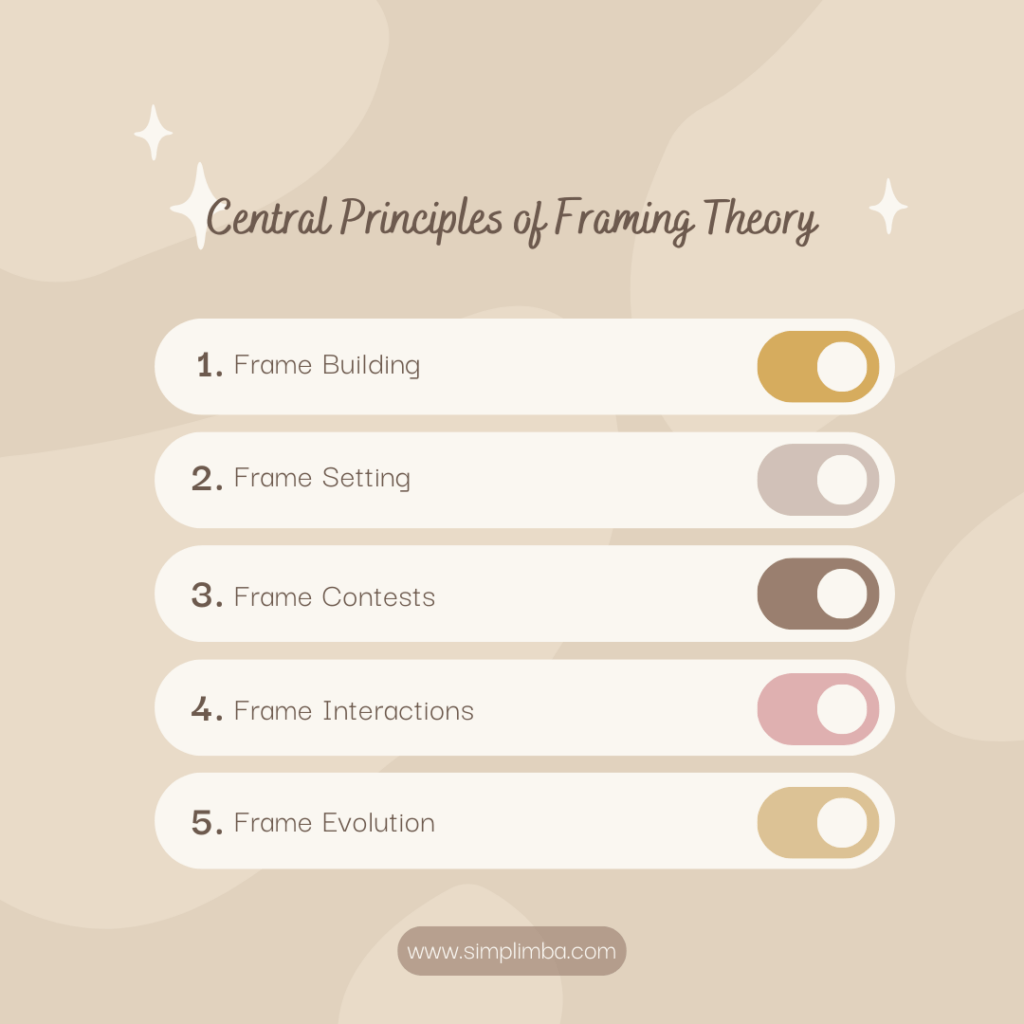
Frame Building: This refers to how frames are constructed by news professionals. Factors such as organizational pressures, journalistic norms, and ideological or political orientations can influence this process.
Frame Setting: This focuses on the effects of frames on audiences. The impacts can vary depending on individuals’ pre-existing knowledge, opinions, and levels of news exposure.
Frame Contests: This refers to conflicts among different frames or interpretations of the same issue. Contests can occur between different media outlets, between media and audiences, or among different segments of the public.
Frame Interactions: This principle acknowledges that frames do not exist in isolation but interact with each other and with broader socio-political contexts.
Frame Evolution: Over time, frames can change or evolve in response to new information, changes in public opinion, or shifts in political power.
Understanding these principles of Framing Theory is crucial for researchers, journalists, and communicators to effectively use and analyze frames in their work.
Exploring the Concepts of Frames
Emphasis Frames
Emphasis framing involves the selective highlighting of certain aspects or perspectives on an issue while downplaying or ignoring others. It helps in shaping the perceptions of the audience by highlighting the magnitude and significance of certain aspects over others. Emphasis framing is rooted in the field of cognitive psychology and communication studies, particularly drawing from theories of selective perception and agenda-setting. This concept is further developed by understanding the role of media and communication strategies in setting public opinion and policy agendas.
Equivalence Frames
Equivalence framing, on the other hand, involves presenting the same issue or information in different ways while preserving the factual equivalence. This type of framing most often occurs in contexts where numerical or statistical information is being presented. The concept of equivalence framing has been developed primarily in the field of decision-making research, particularly in the studies of risk perception and choice under uncertainty. This concept is closely associated with the theory of prospect theory developed by Kahneman and Tversky.
In both types of framing, it is crucial to ensure that the research design, data collection, and data analysis are conducted rigorously and ethically, avoiding any potential biases or misrepresentations. The results should be reported transparently and accurately, acknowledging any limitations or uncertainties. The ultimate goal is to contribute to the scientific understanding of how framing influences perception and decision-making.
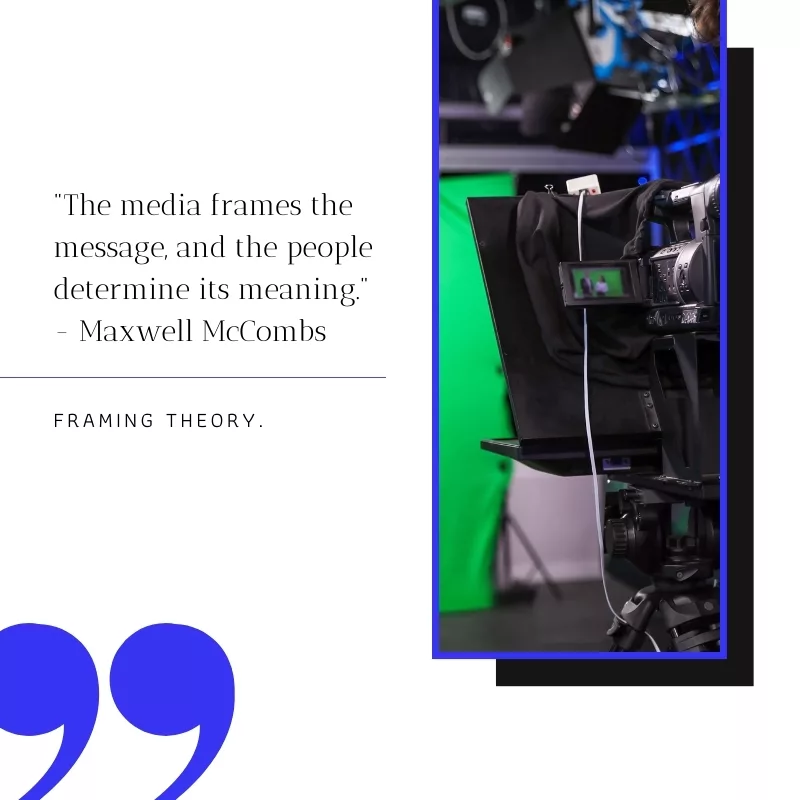
Impact of Framing Theory on Mass Communication
Framing Theory Impacts on Audience Perception
Definition and Conceptualization: Framing is a powerful communication tool that shapes the way we interpret and understand the world around us. It is a cognitive bias where people react to a particular choice in different ways depending on how it’s presented; as a loss or as a gain.
Mechanism: Framing works by influencing our perceptions and attitudes toward the information we encounter. The way information is presented (the ‘frame’) can change how we process that information and thus, our response to it. This is because our brains are wired to make sense of information by placing it within our existing knowledge and experiences (our ‘frames of reference’).
Psychological Basis: The basis of framing’s impact lies in Prospect Theory, proposed by psychologists Daniel Kahneman and Amos Tversky. According to this theory, people make decisions based on the potential value of losses and gains rather than the outcome, and thus, people’s choices can be swayed by how the options are framed.
Real-world Examples of Framing Manipulating Perception
Health Communication: A classic example of framing is in health communication. For instance, if a doctor tells a patient that they have a 90% chance of survival, the patient is likely to feel more optimistic than if told they have a 10% chance of death, even though both statements mean the same thing.
Political Communication: In the political sphere, framing is often used to sway public opinion. For instance, describing a policy as a “tax relief” can make it more popular than calling it a “tax cut”, as the former implies an easing of a burden.
Marketing and Advertising: Companies use framing to make their products or services more appealing. For instance, labeling a product as “75% fat-free” rather than “contains 25% fat” can influence consumers’ purchasing decisions.
Framing Theory Impacts on Agenda Setting
Agenda-setting theory is a concept in media studies, that proposes that the media is powerful enough to influence what issues are considered significant by the public. It was first introduced by Maxwell McCombs and Donald Shaw in 1972 during their study of the 1968 U.S. presidential election. They found that the media’s coverage of certain issues directly influenced what voters perceived as the most important issues.
The theory has two primary assumptions: first, the media filters and shapes reality rather than simply reflects it, and second, the concentration of media coverage on particular issues leads the audience to perceive those issues as more important than others. The theory is often seen in two levels: the first level establishes the issues, while the second level determines the aspects of the issue that are important.
Connection between Agenda-Setting and Framing Theory
While both Agenda-Setting and Framing Theory deal with how media influences public perception, they focus on different aspects. While Agenda-Setting is concerned with the salience of the entire issue, Framing theory focuses on how the presentation of the issue affects its interpretation.
In other words, Agenda-Setting ‘sets the stage’ by determining what issues are newsworthy, and Framing ‘performs the play’ by providing a context or angle from which the issue will be discussed. It’s not just about what the media talks about (agenda-setting), but also how they talk about it (framing). For example, a news story about climate change could be framed in terms of economic implications, ethical concerns, or political debates. The choice of frame can significantly affect how audiences understand and respond to the issue.
Case Studies on Agenda Setting using Framing Theory
In a study by McCombs and Shaw on the 1968 U.S. presidential election, they found a strong correlation between what voters perceived as the most important issue and what the media was reporting as the most pressing issue. This study was significant in establishing the agenda-setting role of the media.
A 2007 study by Kim et al. examined how the media coverage of stem cell research in South Korea affected public perception. They found that the media’s positive framing of the issue led to a high level of public support for stem cell research.
In a 2011 study by Wanta and Hu, they found that the media’s negative framing of nuclear energy after the Fukushima disaster greatly influenced public opinion and led to increased opposition to nuclear energy.
Framing Theory Impacts on Attribute Framing
Attribute framing is a psychological and marketing principle that refers to the bias people display toward the presentation of options or attributes. The way attributes of a situation are framed can significantly influence how individuals perceive and respond to them.
Definition: This term was coined by Amos Tversky and Daniel Kahneman in their seminal work on prospect theory. Attribute framing focuses on the positive or negative aspects of the same attribute, which can lead people to different decisions or judgments, even though the objective information remains the same.
Mechanism: The mechanism of attribute framing revolves around the cognitive biases of the human mind. Positive framing (presenting an attribute in a positive light) generally leads to risk-averse behavior, while negative framing (presenting the same attribute negatively) typically results in risk-seeking behavior. For example, telling someone that a procedure has a 90% success rate (positive framing) will probably elicit a different reaction than saying it has a 10% failure rate (negative framing).
Role of Attribute Framing in Mass Communication
In mass communication, attribute framing plays a significant role in shaping public opinion and consumer behavior.
Advertising: Companies often present identical features of a product or service differently to make it more appealing. For instance, a product might be marketed as 95% fat-free (positive frame) instead of containing 5% fat (negative frame).
Politics: Political campaigns utilize attribute framing extensively to manipulate public opinion. A policy can be framed positively or negatively to sway voters. For instance, a tax increase can be positively framed as funding for public schools or negatively framed as a burden on the middle class.
Media: Media outlets use attribute framing to influence public perception of events. For example, a protest can be framed as a fight for freedom (positive) or as a public disturbance (negative).
Practical Examples of Attribute Framing
Through several studies, the effects of attribute framing have been proven. Here are some practical examples:
Healthcare: In a study by McNeil et al., 1982, physicians were given statistics about the outcomes of two treatments for lung cancer. The treatments were identical, but their outcomes were framed differently. Physicians chose different treatments depending on how the outcomes were framed.
Environment: In a study by Davis, 1995, participants were more willing to support environmentally friendly policies when the environmental damage was framed in terms of losses (negative frame) rather than gains (positive frame).
Retail: In another study, consumers were found to prefer meat labeled as “75% lean” over meat labeled as “25% fat,” even though both descriptions indicate the same product composition.
Framing Theory Impacts on Risk Framing
Risk framing is a concept in behavioral economics that refers to the way choices are presented or framed, which can significantly impact the decision made. The concept is based on Prospect Theory, developed by Daniel Kahneman and Amos Tversky, which suggests that people make decisions based on perceived gains rather than perceived losses. Hence, how a situation or decision is framed can alter the choice one makes.
For instance, consider a medical treatment scenario. If a doctor tells a patient that a procedure has a 90% success rate, it frames the choice in a positive light (gain frame). However, if the doctor says the same procedure has a 10% failure rate, it frames the choice negatively (loss frame). Despite the statistical equivalency, patients often choose differently based on this framing.
The Influence of Risk Framing in Decision-Making:
Risk framing can significantly influence decision-making in various contexts, including financial decisions, health-related decisions, and policy-making.
In financial decision-making, gain-framed messages have been found to encourage investment in riskier but potentially higher yield options, while loss-framed messages tend to promote conservative investments.
In health-related decisions, research has found that gain-framed messages are more effective in promoting preventive health behaviors, like regular exercise and healthy eating, while loss-framed messages are more persuasive for disease detection behaviors, such as cancer screenings.
In policy-making, how a policy is framed can influence public opinion and support. For instance, a policy framed as protecting public health is likely to generate more support than one framed as limiting personal freedom, even if they are the same policy.
Real-Life Instances of Risk Framing:
There are numerous real-life instances of risk framing being used in a variety of contexts.
In marketing, companies often frame their products positively to make them more appealing. For example, a skincare product may be advertised as “improving skin health” (gain frame) rather than “preventing skin damage” (loss frame) to attract more buyers.
In politics, politicians frame their policies to garner public support. For example, a politician might frame an education policy as a way to “increase opportunities for children” (gain frame) rather than “reduce the education gap” (loss frame).
In healthcare, doctors and medical personnel employ risk framing when discussing treatment options with patients. For instance, they might present a surgical procedure in terms of its success rate (gain frame) instead of its failure rate (loss frame) to influence the patient’s decision.
These examples underscore the pervasive influence of risk framing in our daily lives and decision-making processes. Its understanding is crucial for effective communication, marketing, policy-making, and even interpersonal relationships.
Framing Theory Impacts on Attribute Framing
Social framing refers to the process by which individuals, groups, or societies interpret, perceive, and assign meaning to events, issues, or information in specific social contexts. This concept is deeply rooted in sociology, communication studies, psychology, and political science. It is a significant tool for understanding how individuals and societies interact with, understand, and communicate about the world around them.
Framing theory, proposed by sociologist Erving Goffman, suggests that people rely on “frames,” or preconceived notions and structures, to make sense of complex issues. According to this theory, the way an issue or event is framed can significantly influence people’s attitudes, beliefs, and actions. In other words, frames act as interpretive schemas that guide our understanding and interpretation of reality.
How Social Framing Shapes Public Opinion
Social framing plays a crucial role in shaping public opinion. It influences how people perceive and understand social, political, economic, and environmental issues.
For instance, media outlets often use specific frames or perspectives when reporting news stories. These frames can influence how audiences perceive and interpret the presented issues, directly impacting public opinion. A classic example is the “war on terror” frame, which dramatically influenced public opinion about foreign policy and national security after 9/11.
Besides media, other social institutions like education and government can also shape public opinion through social framing. They can present information in a way that conveys a particular perspective, leading people to view issues from that standpoint.
Case Studies of Social Framing in Action
Civil Rights Movement: The civil rights movement provides a compelling example of social framing in action. Activists strategically framed the movement as a moral and constitutional struggle, which significantly impacted public perception of civil rights issues. This framing helped garner widespread public support and led to significant legislative changes.
Climate Change: The framing of climate change significantly influences public response to this issue. When framed as a distant and uncertain threat, people are less likely to support aggressive climate action. On the other hand, when framed as an immediate and local threat, public support for climate action increases.
COVID-19 Pandemic: The way the COVID-19 pandemic has been framed has significantly influenced public behavior and policy responses. For instance, countries that framed the pandemic as a severe health crisis were more likely to adopt strict public health measures and experienced higher compliance with these measures.
Framing Theory Impacts on IssueFraming
Detailed Look at Issue Framing
Issue framing refers to presenting a problem or issue in a particular light or context to shape people’s perception or understanding of it. This is a common practice in the world of politics, media, and social sciences, where framing is used to highlight or underscore certain aspects of an issue while downplaying or omitting others.
Issue framing comprises two major components: frame setting and frame building. Frame setting is the process of setting the context for an issue, while frame building involves the construction of news reports or political speeches. The effectiveness of issue framing depends on several factors, including the credibility of the source, the consistency of the frame with the audience’s existing beliefs, and the level of audience engagement with the issue.
The Effect of Issue Framing on Political and Social Issues:
Issue framing has a significant impact on the public’s perception of political and social issues. For instance, by framing an issue like immigration in terms of security (e.g., “protecting our borders”), politicians can stir up fear and resentment against immigrants. Conversely, framing immigration in terms of human rights (e.g., “providing refuge to those fleeing violence”) can elicit empathy and support for immigrant rights.
In a research study by Nelson, Oxley, and Clawson (1997), participants who were presented with a news story about a protest framed as a “riot” showed more negative attitudes towards the protesters than those who read the same story framed as a “demonstration”. This shows how issue framing can shape public opinion and influence social and political outcomes.
Examples of Issue Framing in Media
Media plays a crucial role in issue framing. For instance, during the 2008 financial crisis, some media outlets framed the issue as a result of “greedy bankers” taking unnecessary risks, which led to public anger and demand for regulatory reform.
In another example, climate change has been framed in various ways in the media. Some outlets present it as a dire problem requiring urgent action (“Scientists warn of impending climate catastrophe”), while others frame it as a contentious issue with considerable scientific disagreement (“Debate continues over human role in climate change”). These varying frames significantly influence public understanding and policy positions on climate change.
Framing Theory Impacts on Time Framing
An Overview of Time Framing
Time framing is a crucial aspect of understanding the flow of events in any social phenomenon. It refers to the temporal context in which events, issues, or actions are placed and interpreted. In the world of academia, time framing is employed to understand the sequence, duration, and frequency of events, thus providing a comprehensive overview of the phenomena under study.
Definition and Importance: Time framing is defining the chronology of events or the timeframe within which a phenomenon happens. It’s vital in analyzing trends, patterns, and relationships among variables over a specified period.
Types of Time Frames: Time frames can be instantaneous (snapshots of a single point in time), longitudinal (over an extended period), or cyclical (recurring patterns). Understanding these types helps researchers to better design their studies.
Analysis of Time Framing’s Role in News Reporting
Time framing plays an essential role in news reporting and media studies, influencing how audiences perceive and interpret news events.
Time Framing in News Cycles: The news cycle, the period during which a news story remains relevant and reported, heavily relies on time framing. Stories are framed within specific temporal boundaries, affecting the length and depth of coverage.
Impact on Audience Perception: The time frame chosen to report news can influence audience perception. For instance, a story framed over a long timeframe might suggest it is an ongoing issue, whereas a short timeframe might create a sense of urgency.
Illustrations of Time Framing in Various Media Contexts
To further illustrate the role of time framing, let’s consider various media contexts.
Social Media: The timeframe in social media platforms is incredibly short, with the life of posts ranging from a few minutes to a few hours. This short time frame can impact the spread of information and the shelf life of news on these platforms.
Television: Time frames in television news can vary, from brief news flashes to extended coverages. The choice of time frame can influence the depth of coverage and the audience’s understanding of the story.
Print Media: In print news, time frames are often longer, allowing for more in-depth coverage and analysis of events. This extended time frame can influence the thoroughness and complexity of the stories presented.
Criticisms of Framing Theory in Mass Communication
Ethical Considerations
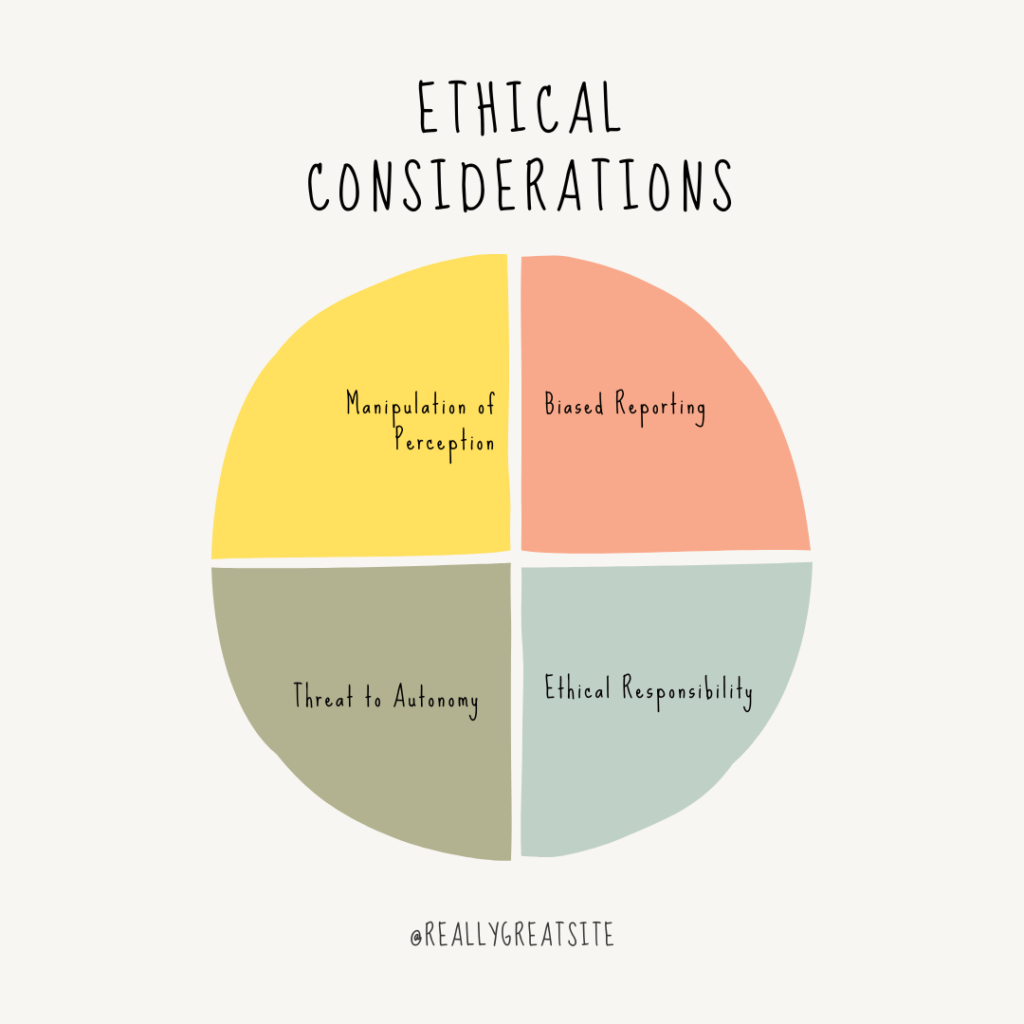
Manipulation of Perception: One of the primary ethical concerns of framing in mass communication is the tendency to manipulate perception. This is because framing often involves highlighting specific aspects of a story or issue while downplaying others, which can lead to disproportionate emphasis and misrepresentation.
Biased Reporting: Framing can result in biased reporting, particularly when it is used to promote specific ideologies or agendas. If the media or communicator has a particular bias, they may frame stories or issues in a way that aligns with their views, potentially leading to misinformation or a skewing of public perception.
Threat to Autonomy: Framing can be seen as a threat to individuals’ autonomy by influencing how they perceive and interpret information. This can undermine their ability to form independent opinions and make informed decisions.
Ethical Responsibility: Media entities and communicators have a social responsibility to present information in an unbiased, accurate, and comprehensive manner. The misuse of framing can compromise these ethical standards, potentially resulting in a loss of public trust and credibility.
The Downsides and Misuse of Framing Theory in Mass Communication
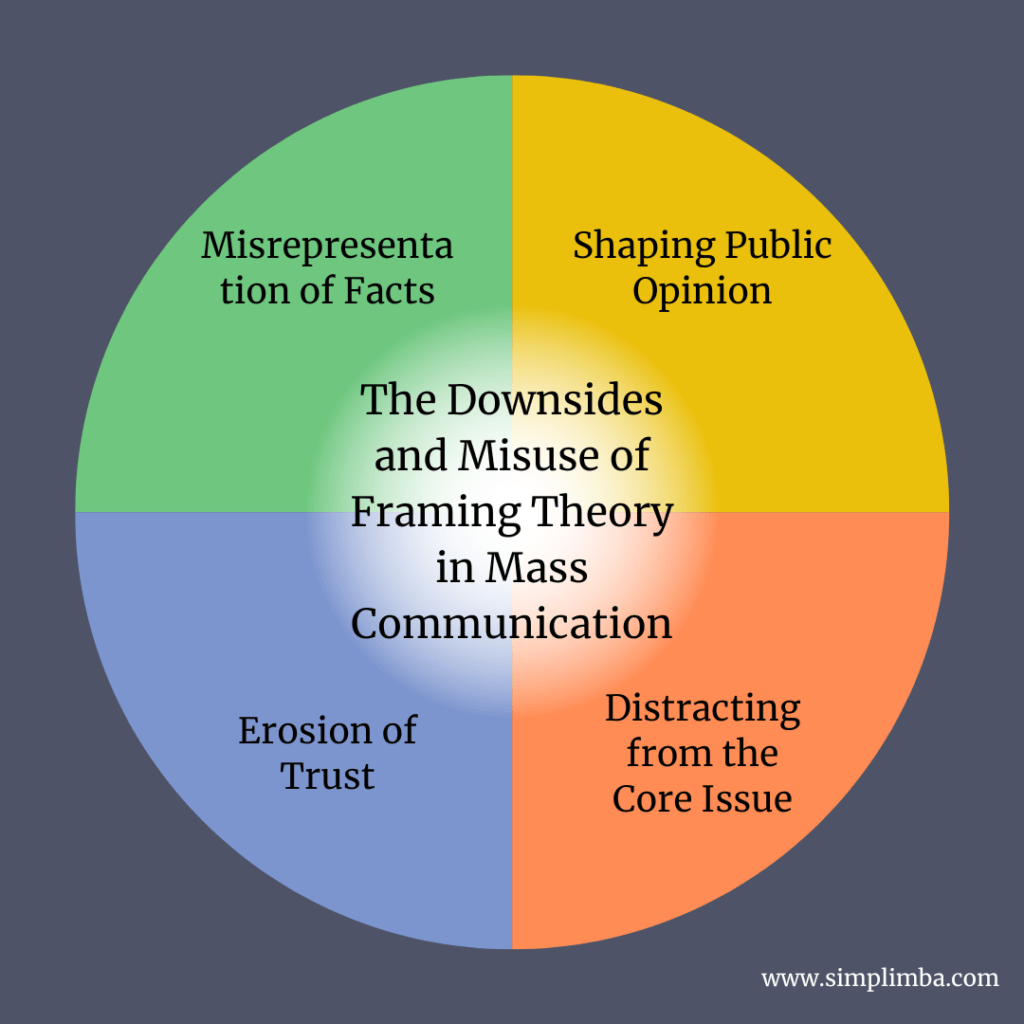
Misrepresentation of Facts: The framing theory can be misused to distort facts and present misleading narratives. This could be done intentionally for various purposes like propaganda, manipulation, or unintentionally due to bias or lack of comprehensive information.
Shaping Public Opinion: Framing can significantly influence public opinion, often not based on factual information but rather on how the information is presented. This can lead to a polarized society, with divisions based more on perception than reality.
Distracting from the Core Issue: The use of framing can also draw attention away from the core issues in a story or discussion. By highlighting specific aspects and downplaying others, framing can shift focus and even distract from the actual matter at hand.
Erosion of Trust: The misuse of framing can lead to an erosion of trust in the media or the communicator. If audiences perceive that the framing of information is biased or misleading, it can result in decreased trust and credibility
Samrat is a Delhi-based MBA from the Indian Institute of Management. He is a Strategy, AI, and Marketing Enthusiast and passionately writes about core and emerging topics in Management studies. Reach out to his LinkedIn for a discussion or follow his Quora Page
